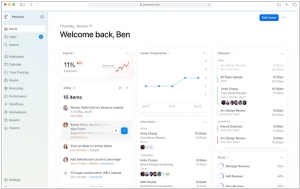Figma vs Milanote
March 10, 2025 | Author: Adam Levine
27★
The collaborative interface design tool. Each contributor owns their part of the creative process and stays in sync along the way - across any platform. Securely connect teams, fonts, and libraries across your entire company.
8★
Milanote is an easy-to-use tool to organize your ideas and projects into visual boards. Add notes, images, links and files, organize them visually and share them with your team. Offers templates for brainstorming, project planning, and mood boards.
See also:
Top 10 Note Taking apps for business
Top 10 Note Taking apps for business
Figma and Milanote are both online tools that let people move things around on a screen while feeling highly productive. They thrive on collaboration, meaning multiple users can poke at the same project simultaneously, which is either teamwork or digital chaos, depending on the team. Both have free plans, paid plans and the nagging sense that you should be doing more with them. They exist in browsers, require no installation, and—much like the meaning of life—are flexible but slightly elusive when you try to explain them to your grandparents.
Figma was born in the United States in 2012, which makes it old enough to complain about “kids these days” but still too young to know what a fax machine is. It is a serious tool for serious designers who want to create beautiful UI/UX designs, prototype interactive experiences and hand them off to developers, who will then look at them and say, “That’s nice, but can we change everything?” It deals with vector graphics, components and design systems, which means it’s essentially the digital equivalent of a very tidy, obsessive-compulsive architect.
Milanote, on the other hand, sprang into existence in 2017 in Australia, where people presumably needed a place to dump all their creative ideas before getting distracted by the local wildlife. It is less about precision and more about joyful chaos, allowing users to create mood boards, brainstorm freely and arrange ideas in ways that make sense only to them. There are no fancy vector tools, no prototyping and certainly no developers shaking their heads in dismay—just a vast, open canvas for the creative mind to meander through, occasionally stopping to admire its own brilliance before wandering off to make tea.
See also: Top 10 Note Taking apps
Figma was born in the United States in 2012, which makes it old enough to complain about “kids these days” but still too young to know what a fax machine is. It is a serious tool for serious designers who want to create beautiful UI/UX designs, prototype interactive experiences and hand them off to developers, who will then look at them and say, “That’s nice, but can we change everything?” It deals with vector graphics, components and design systems, which means it’s essentially the digital equivalent of a very tidy, obsessive-compulsive architect.
Milanote, on the other hand, sprang into existence in 2017 in Australia, where people presumably needed a place to dump all their creative ideas before getting distracted by the local wildlife. It is less about precision and more about joyful chaos, allowing users to create mood boards, brainstorm freely and arrange ideas in ways that make sense only to them. There are no fancy vector tools, no prototyping and certainly no developers shaking their heads in dismay—just a vast, open canvas for the creative mind to meander through, occasionally stopping to admire its own brilliance before wandering off to make tea.
See also: Top 10 Note Taking apps





